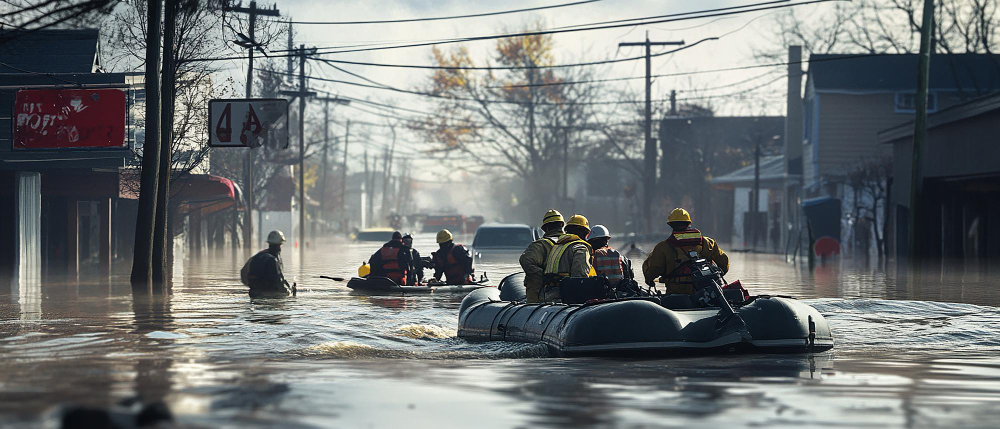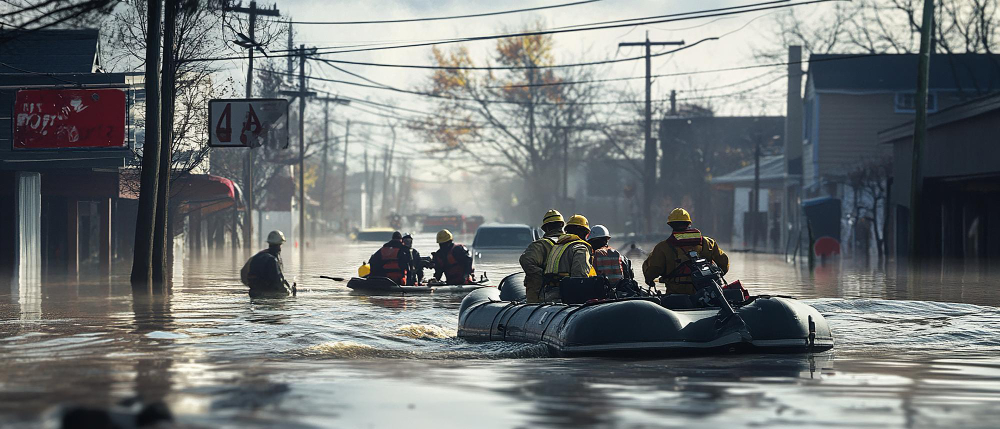
Disasters, both natural and artificial, bring widespread destruction and negatively impact communities, economies, and lives. The recovery process and rebuilding from such disasters are tedious and take long periods. Insurance assumes a very significant role in disaster recovery and alleviation efforts by providing monetary security and backing to the affected individuals, businesses, and governments alike. This enables an affected party to easily rebuild their lives and resume some normalcy. From compensation for property damages to funds for the restoration of infrastructures, insurance plays a very essential role in reducing the financial impact of disasters.
Stability in Finances and Faster Recovery
Among the major roles of insurance in disaster recovery, ensuring the stability of the finances in the affected parties is the major one. Their immediate outcome at the time of disasters includes massive property damage, loss of earning ability, and sudden extra expenses. Without insurance, individuals or organizations would have to bear the full cost of damages, which can often be financially crippling. An insurance policy, whether for a residence, business establishment, or personal property, provides funds for repairing or replacing damaged property.
This financial support helps individuals and businesses recover more quickly, thereby reducing the potential long-term economic effects of the event.
Business Continuity
Insurance plays an important role in business continuity in times of disaster. Business interruption insurance covers lost income during the period when a business is closed due to a disaster. This coverage is crucial for SMEs, which may not have the financial reserves to absorb the impact of a prolonged closure.Thus, through insurance, jobs are maintained, local economies are supported, and further economic decline in the locales is avoided.
Rebuilding of Infrastructure and Public Welfare
Insurance’s role in rebuilding infrastructure and public welfare efforts is paramount at higher levels. It is to the insurance and reinsurance companies that governments turn for support in covering the enormous cost of rebuilding public infrastructure, from roads and bridges to public buildings. This is what helps in financing support to quickly reinstate services—critical to the overall recovery—for affected communities. Besides, insurance payouts aid public relief operations by providing the wherewithal to sustain disaster victims with temporary shelter, food, and healthcare.
Encouragement of Risk Management and Preparedness
Insurance also plays an indirect role in disaster preparedness by encouraging better risk management practices. Frequently, as a precondition for policy approval, insurance companies require policyholders to implement measures to reduce the risk of damage. For example, this might include using fire-resistant materials in house construction or adopting flood mitigation strategies in flood-prone areas. Through such, the overall impact of disasters is reduced; hence, recovery becomes easy and cheap. Again, insurance availability can compel the urban planning and development process to shift these communities toward areas with fewer disasters.
Read More – Importance of Workmen Compensation Insurance
Forms of Disaster Insurance
Disaster insurance is not uniform in nature; rather, it comes in many forms designed to address different types of risks and needs. It is important to describe these various forms of disaster insurance for those seeking coverage for potential losses. The major ones include property insurance, business disruption insurance, and specialized disaster coverage like flood, earthquake, and hurricane insurance.
Property Insurance
This is the most basic form of insurance against disasters, covering both personal and business physical assets. It covers homes, buildings, equipment, and inventory. Property insurance usually covers destruction due to general disasters such as fire, storm, and vandalism. However, some, such as flooding and earthquakes, often require additional coverage.
Business Interruption Insurance
As mentioned, this type of insurance is crucial for businesses that could lose income if a disaster occurs. Business interruption insurance helps recover the income lost during the period when a business is not operating.
This insurance ensures that financial commitments, such as payroll and rent, can still be met even when the business is not generating revenues.
Flood Insurance
Floods are among the most common and devastating natural catastrophes regarding loss. However, most traditional property insurance policies exclude coverage for flood damage.
Flood insurance specifically covers damage caused by flooding. It can extend to covering repairs or replacement of buildings and personal belongings affected by a flood.
Earthquake Insurance
This is another type of special policy orientated to cover damage from seismic activities. Earthquake insurance is particularly important in areas with high earthquake risk, as standard property insurance typically does not cover earthquake damage.
This type of insurance usually covers repair costs for damage to buildings and personal property. It can also cover additional living expenses if the insured property becomes uninhabitable.
Hurricane Insurance
People living on the coasts feel the importance of hurricane insurance most. Here property insurance may cover some damages caused by hurricanes, like wind damage, but often excludes damages caused due to storm surges and flooding. Hurricane insurance covers this gap and further ensures all-around or overall coverage of hurricane damage.
The Role of Reinsurance in Disaster Recovery
Reinsurance is a crucial component in the business recovery process from catastrophes. It provides insurance firms with protection against large-scale losses.
When an insurer faces significant claims after a calamity, it can spread this risk through reinsurance. This allows the insurer to recapture part of the payout costs from a reinsurer.
As a result, insurance companies remain solvent even during a catastrophe and can continue to meet their commitments to policyholders.
Reinsurance plays an extremely important role in countries that experience frequent and serious natural catastrophes, where the risk of major losses is very high.
By spreading the risk, reinsurance enables insurers to offer disaster coverage to more customers. This, in turn, increases the resilience of communities against disasters.
Read More – What are Riders in Life Insurance Policies?
Public-Private Partnerships in Disaster Insurance
In this connection, public-private cooperation is carrying out the role of disaster insurance, mainly where the level of risks goes beyond the capacity of private insurance companies alone. Such public-private partnerships will make it possible to develop and adopt innovative programs to increase disaster resilience and stimulate recovery.
An example is government reinsurance or subsidization to urge private insurance companies into coverage in high-risk areas. This way, government-backed insurance programs can help ensure that vital public infrastructure, such as hospitals, schools, utilities, and the like, caters to risks associated with disasters.
Government-sponsored insurance programs exist in many countries, such as the National Flood Insurance Program in the United States. These programs are designed to cover disasters that are not insurable in the private marketplace.
Such programs ensure that insurance pools are available at low-cost rates for agents and communities. This helps prevent the public sector from bearing the full cost of disaster recovery.
Challenges and Future Directions in Disaster Insurance
While insurance contributes in a big way in the recovery process of disasters, there still have had numerous challenges toward optimum effectiveness. One of the main problems is underinsurance, where individuals and businesses are not accorded sufficient cover that can be able to uplift them fully from the disasters. This is because of risk unawareness or that the comprehensive insurance policies are expensive. The way forward will have to involve educating the public over the need for sufficient insurance coverage and, hence, how to make this affordable.
A second factor is that climate change has made natural catastrophes more frequent and severe. The increased possible insurance cost corresponds to the increased possibility of disasters. The result has been a trend of increasing premiums and in some cases, an exodus of insurance companies from high-risk areas. The insurance industry, governments, and communities need to work together on such innovative solutions as micro insurance, risk-sharing pools, and climate-resilient infrastructure.
The future of disaster insurance may increasingly rely on big data and artificial intelligence. These technologies are distinguished by their sophisticated capabilities in improving risk assessment and creating accurate pricing models.
Big data and AI facilitate better prediction and preparedness for insurers in the face of disasters. As a result, they may lead to more effective and cost-efficient insurance solutions.
The Need for a Holistic Approach to Disaster Management
Although insurance is an integral part of disaster recovery, it cannot be a solution by itself. It is essential to adopt a comprehensive view of disaster management, including prevention, preparedness, response, and recovery, to minimize the impact of disasters.
Insurance should be considered not as a standalone solution but as a vital component of a broader strategy. This strategy should also include risk mitigation through improved building codes, warning systems, community education programs, and other measures.
This requires cooperation at all levels among governments, the private sector, and civil society to ensure that communities are disaster-resilient. It means not only investing in insurance but in infrastructure, education, and policy really making a community less vulnerable to disasters. By taking proactive management measures, the overall impact of the disaster will be lessened, thus providing a faster and more sustainable recovery.
Role of AapKaPolicyWala in Disaster Recovery
AapKaPolicyWala is another upcoming online marketplace for insurance that contributes a lot toward disaster recovery through hassle-free, end-to-end insurance solutions in India for both individuals and businesses. There are host policies on this platform so that customers can fasten the process of getting financial help in times of disaster. Hereby, AapKaPolicyWala provides the tools necessary to allow its users to make informed decisions, thus enhancing their capability to be more resilient and prepared against uncertainties. Such proactive measures not only help in speedy recovery but also raise the culture of risk awareness and management, which is significant for the reduction of the disaster’s impact in the long run.
Conclusion
Clearly, insurance has an intrinsic role to play in disaster recovery and relief efforts. Insurance provides financial stability, business continuity, and support for infrastructure rebuilding. It also promotes better risk management, which is critical for the recovery and rebuilding process in disaster-hit communities.
Portals like AapKaPolicyWala facilitate this process by making insurance more accessible and tailored to individual and business needs. This helps prepare them to face the challenges of disaster recovery.
Given the increasing frequency and severity of disasters, the importance of insurance in disaster preparedness and recovery will only grow. It is a crucial link in any comprehensive disaster management strategy.


One Response